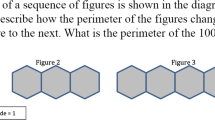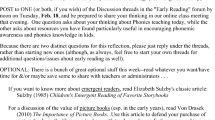Abstract
We provide actionable strategies that teachers can follow when implementing asynchronous video communication and feedback in their own courses. These strategies are based on our own research over many years in the use of asynchronous video in online teaching, as well as our review of the literature, and are provided to foster greater discussion on the pedagogical strategies surrounding the use of video in online teaching.
Similar content being viewed by others
References
Allen, M., Omori, K., Burrell, N., Mabry, E., & Timmerman, E. (2013). Satisfaction with distance education. Handbook of Distance Education, 2013, 143–154. doi:10.1348/000709905X2699.
Allen, I. E., Seaman, J., Poulin, R., & Taylor Straut, T. (2016). Online report card: Tracking online education in the United States. Babson Survey Research Group and Quahog Research Group. http://onlinelearningsurvey.com/reports/onlinereportcard.pdf.
Borup, J., West, R. E., & Graham, C. R. (2012). Improving online social presence through asynchronous video. The Internet and Higher Education, 15(3), 195–203.
Borup, J., West, R. E., & Graham, C. R. (2013). The influence of asynchronous video communication on learner social presence: A narrative analysis of four cases. Distance Education, 34(1), 48–63.
Borup, J., West, R. E., Thomas, R., & Graham, C. R. (2014). Examining the impact of video feedback on instructor social presence in blended courses. The International Review of Research in Open and Distributed Learning, 15(3). doi:10.19173/irrodl.v15i3.1821.
Borup, J., West, R. E., & Thomas, R. (2015). The impact of text versus video communication on instructor feedback in blended courses. Educational Technology Research and Development, 63(2), 161–184.
Barrow, T. H. (2012). Social presence in the asynchronous online classroom: The asynchronous online video conversation (unpublished doctoral dissertation). Lubbock: Texas Tech University.
Beckstrom, T. (2016). An implementation evaluation of the distance observation method for special education teacher candidates. Unpublished master’s project.
Boling, E. C., Hough, M., Krinsky, H., Saleem, H., & Stevens, M. (2012). Cutting the distance in distance education: Perspectives on what promotes positive, online learning experiences. The Internet and Higher Education, 15(2), 118–126.
Boyer, E., Miltenberger, R. G., Batsche, C., Fogel, V., & LeBlanc, L. (2009). Video modeling by experts with video feedback to enhance gymnastics skills. Journal of Applied Behavior Analysis, 42(4), 855–860.
Bulu, S. T. (2012). Place presence, social presence, co-presence, and satisfaction in virtual worlds. Computers & Education, 58(1), 154–161.
Capdeferro, N., & Romero, M. (2012). Are online learners frustrated with collaborative learning experiences? The International Review Of Research In Open And Distributed Learning, 13(2), 26–44 http://www.irrodl.org/index.php/irrodl/article/view/1127/2129.
Crook, A., Mauchline, A., Maw, S., Lawson, C., Drinkwater, R., Lundqvist, K., Orsmond, P., Gomez, S., & Park, J. (2012). The use of video technology for providing feedback to students: Can it enhance the feedback experience for staff and students? Computers & Education, 58(1), 386–396.
Cuthrell, K., Fogarty, E. A., & Anderson, P. J. (2009). “is this thing on?” university student preferences regarding audio feedback. In Society for Information Technology & Teacher Education International Conference (pp. 32–35).
Draft, R. L., & Lengel, R. H. (1986). Organizational information requirements, media richness and structural design. Management Science, 32(5), 554–571.
Freidhoff, J. R. (2016). Michigan’s K-12 virtual learning effectiveness report 2014–2015. Lansing: Michigan Virtual University. http://media.mivu.org/institute/pdf/er_2015.pdf.
Garrison, D. R., Anderson, T., & Archer, W. (1999). Critical inquiry in a text-based environment: Computer conferencing in higher education. The Internet and Higher Education, 2(2), 87–105.
Getzlaf, B., Perry, B., Toffner, G., Lamarche, K., & Edwards, M. (2009). Effective instructor feedback: Perceptions of online graduate students. The Journal of Educators Online, 6(2), 1–22.
Graham, C. R. (2006). Blended learning systems: Definition, current trends, and future directions. In C. J. Bonk & C. R. Graham (Eds.), Handbook of blended learning: Global perspectives, local designs (pp. 3–21). San Francisco: Pfeiffer Publishing.
Griffiths, M. E., & Graham, C. R. (2009a). The potential of asynchronous video in online education. Distance Learning, 6(2), 13–23.
Griffiths, M. E., & Graham, C. R. (2009b). Using asynchronous video in online classes: Results from a pilot study. International Journal of Instructional Technology and Distance Learning, 6(3), 65–76.
Gunawardena, C. N. (1995). Social presence theory and implications for interaction and collaborative learning in computer conferences. International Journal of Educational Telecommunications, 1(2/3), 147–166.
Gunawardena, C. N., & Zittle, F. J. (1997). Social presence as a predictor of satisfaction within a computer-mediated conferencing environment. American Journal of Distance Education, 11(3), 8–26.
Harper, F., Green, H., & Fernandez-Toro, M. (2012). Evaluating the integration of Jing screencasts in feedback on written assignments. In 2012 15th International Conference on Interactive Collaborative Learning (ICL) (pp. 1–7). IEEE. doi:10.1109/ICL.2012.6402092.
Harrison, D. J. (2015). Assessing experiences with online educational videos: Converting multiple constructed responses to quantifiable data. International Review of Research in Open and Distributed Learning, 16(1), 168–192 http://eric.ed.gov/?id=EJ1061070.
Harrison, J. B., & West, R. E. (2014). Sense of community in a blended technology integration course: A design-based research study. The International Review of Research in Open and Distributed Learning, 15(6). doi:10.19173/irrodl.v15i6.1907.
Hart, C. (2012). Factors associated with student persistence in an online program of study: A review of the literature. Journal of Interactive Online Learning, 11(1), 19–42.
Hawkins, S. C., Osborne, A., Schofield, S. J., Pournaras, D. J., & Chester, J. F. (2012). Improving the accuracy of self-assessment of practical clinical skills using video feedback–the importance of including benchmarks. Medical Teacher, 34(4), 279–284.
Henderson, M., & Phillips, M. (2015). Video-based feedback on student assessment: Scarily personal. Australasian Journal of Educational Technology, 31(1), 51–66. doi:10.14742/ajet.v0i0.1878.
Hew, K. F., & Cheung, W. S. (2013). Audio-based versus text-based asynchronous online discussion: Two case studies. Instructional Science, 41(2), 365–380. doi:10.1007/s11251-012-9232-7.
Hughes, G. D. (2008). Using videos to bring lecture to the online classroom. College Quarterly, 12(1). http://eric.ed.gov/?id=EJ864472.
Inglis, A. (1998). Video email: A method of speeding up assignment feedback for visual arts subjects in distance education. British Journal of Educational Technology, 29(4), 343–354. doi:10.1111/1467-8535.00080.
Khurana, C., & Boling, E. (2010). “setting the climate”: The role of instructional design and multimedia to enhance social presence. In World Conference on Educational Media, Hypermedia, and Telecommunications (pp. 1813–1818).
Kim, J., Kwon, Y., & Cho, D. (2011). Investigating factors that influence social presence and learning outcomes in distance higher education. Computers & Education, 57(2), 1512–1520.
Kirschner, P. a., Brink, H., & Meester, M. (1991). Audiotape feedback for essays in distance education. Innovative Higher Education, 15(2), 185–195. doi:10.1007/BF00898030.
Leijen, Ä., Lam, I., Wildschut, L., Simons, P. R. J., & Admiraal, W. (2009). Streaming video to enhance students’ reflection in dance education. Computers & Education, 52(1), 169–176.
McCarthy, J. (2015). Evaluating written, audio and video feedback in higher education summative assessment tasks. Issues in Educational Research, 25(2), 153–169.
Moore, N. S., & Filling, M. L. (2012). iFeedback: Using video technology for improving student writing. Journal of College Literacy & Learning, 38, 3–14.
Palloff, R. M., & Pratt, K. (2007). Building online learning communities: Effective strategies for the virtual classroom (2nd ed.). San Francisco: Jossey-Bass.
Parsad, B., & Lewis, L. (2008). Distance education at degree-granting postsecondary institutions: 2006–07. Washington, D.C.: National Center for Education Statistics http://nces.ed.gov/pubs2009/2009044.pdf.
Rodway-Dyer, S., Knight, J., & Dunne, E. (2011). A case study on audio feedback with geography undergraduates. Journal of Geography in Higher Education, 35(2), 217–231. doi:10.1080/03098265.2010.524197.
Rourke, L., Anderson, T., Garrison, D. R., & Archer, W. (1999). Assessing social presence in asynchronous text-based computer conferencing. Journal of Distance Education, 14(2), 50–71.
Rourke, L., Anderson, T., Garrison, D. R., & Archer, W. (2007). Assessing social presence in asynchronous text-based computer conferencing. International Journal of E-Learning & Distance Education, 14(2), 50–71.
Short, J., Williams, E., & Christie, B. (1976). The social psychology of telecommunications. New York: John Wiley & Sons.
Silva, M. L. (2012). Camtasia in the classroom: Student attitudes and preferences for video commentary or Microsoft word comments during the revision process. Computers and Composition, 29(1), 1–22. doi:10.1016/j.compcom.2011.12.001.
Swan, K., & Shih, L. F. (2005). On the nature and development of social presence in online course discussions. Journal of Asynchronous Learning Networks, 9(3), 115–136.
Thomas, R. A., West, R. E., & Borup, J. (2017). An analysis of instructor social presence in online text and asynchronous video feedback comments. The Internet and Higher Education, 33, 61–73.
Thomson, A., Bridgstock, R., & Willems, C. (2014). "teachers flipping out" beyond the online lecture: Maximising the educational potential of video. Journal of Learning Design, 7(3), 67–78.
Velasquez, A., Graham, C. R., & West, R. E. (2013). An investigation of practices and tools that enabled technology-mediated caring in an online high school. The International Review of Research in Open and Distributed Learning, 14(5). doi:10.19173/irrodl.v14i5.1465.
Wood, K. A., Moskovitz, C., & Valiga, T. M. (2011). Audio feedback for student writing in online nursing courses: Exploring student and instructor reactions. The Journal of Nursing Education, 50(9), 540–543. doi:10.3928/01484834-20110616-04.
Young, S., & Duncan, H. E. (2014). Online and face-to-face teaching: How do student ratings differ? MERLOT Journal of Online Learning and Teaching, 10(1), 70–79.
Acknowledgements
We gratefully acknowledge Patrick Lowenthal at Boise State University and Gregory Grimsby from George Mason University for reviewing our findings and providing additional recommendations based on their wealth of experience using video feedback.
Author information
Authors and Affiliations
Corresponding author
Rights and permissions
About this article
Cite this article
West, R.E., Jay, J., Armstrong, M. et al. “Picturing Them Right in Front of Me”: Guidelines for Implementing Video Communication in Online and Blended Learning. TechTrends 61, 461–469 (2017). https://doi.org/10.1007/s11528-017-0208-y
Published:
Issue Date:
DOI: https://doi.org/10.1007/s11528-017-0208-y




